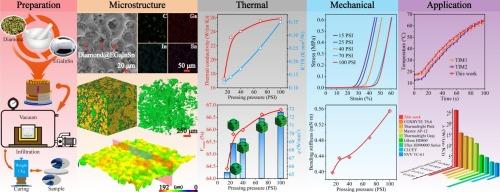Controllable construction and performance response regulation of diamond@EGaInSn-based bicontinuous phase thermal interface materials
IF 8.1
2区 材料科学
Q1 ENGINEERING, MANUFACTURING
Composites Part A: Applied Science and Manufacturing
Pub Date : 2025-10-02
DOI:10.1016/j.compositesa.2025.109332
引用次数: 0
Abstract
The relentless miniaturization and 3D integration of high-power electronic devices have created an urgent demand for thermal interface materials (TIMs) that simultaneously achieve high thermal conductivity and mechanical compliance. Here, diamond@EGaInSn (Eutectic gallium indium tin alloy)/polysiloxane bicontinuous phase (BCP) thermal pads with high thermal performance and excellent elasticity were fabricated via molding combined with low-temperature vacuum infiltration. Remarkably, microstructural analysis confirms the formation of interpenetrating diamond@EGaInSn and polysiloxane 3D networks, where EGaInSn alloy uniformly coats diamond surfaces and forms liquid bridges to create continuous thermal pathways. This thermal pad achieves a high thermal conductivity of 25.85 W/(m·K) and ultralow interfacial contact thermal resistance (ICTR) of 0.35 K·mm2/W, significantly outperforming commercial TIMs. The BCP thermal pads achieves exceptional compressive properties and mechanical robustness (deformation less than 20 μm) through EGaInSn’s dual functionality as both thermal conductor and deformable matrix. The bending stiffness of BCP thermal pads increases with applied pressure due to reduced interparticle spacing and enhanced mechanical interlocking between diamond reinforcements. Heat dissipation test results show that the BCP thermal pad exhibits superior thermal conductivity to commercial TIMs. In summary, this bicontinuous phase design provides a new paradigm for multifunctional TIMs.

diamond@EGaInSn-based双连续相热界面材料的可控结构及性能响应调控
大功率电子器件的不断小型化和3D集成化对热界面材料(TIMs)产生了迫切的需求,同时实现高导热性和机械顺应性。本文采用模压法结合低温真空浸渗法制备了热学性能高、弹性好的diamond@EGaInSn(共晶镓铟锡合金)/聚硅氧烷双连续相(BCP)热垫。值得注意的是,显微结构分析证实了互穿diamond@EGaInSn和聚硅氧烷3D网络的形成,EGaInSn合金均匀地覆盖在金刚石表面,形成液体桥,形成连续的热通道。该热垫具有25.85 W/(m·K)的高导热系数和0.35 K·mm2/W的超低界面接触热阻(ICTR),显著优于商用TIMs。通过EGaInSn作为热导体和可变形基质的双重功能,BCP热垫实现了卓越的压缩性能和机械稳健性(变形小于20 μm)。BCP热垫的抗弯刚度随着施加压力的增加而增加,这是由于减小了颗粒间距和增强了金刚石增强剂之间的机械联锁。散热测试结果表明,BCP热垫的导热性能优于商用热垫。总之,这种双连续相位设计为多功能tim提供了一种新的范例。
本文章由计算机程序翻译,如有差异,请以英文原文为准。
求助全文
约1分钟内获得全文
求助全文
来源期刊

Composites Part A: Applied Science and Manufacturing
工程技术-材料科学:复合
CiteScore
15.20
自引率
5.70%
发文量
492
审稿时长
30 days
期刊介绍:
Composites Part A: Applied Science and Manufacturing is a comprehensive journal that publishes original research papers, review articles, case studies, short communications, and letters covering various aspects of composite materials science and technology. This includes fibrous and particulate reinforcements in polymeric, metallic, and ceramic matrices, as well as 'natural' composites like wood and biological materials. The journal addresses topics such as properties, design, and manufacture of reinforcing fibers and particles, novel architectures and concepts, multifunctional composites, advancements in fabrication and processing, manufacturing science, process modeling, experimental mechanics, microstructural characterization, interfaces, prediction and measurement of mechanical, physical, and chemical behavior, and performance in service. Additionally, articles on economic and commercial aspects, design, and case studies are welcomed. All submissions undergo rigorous peer review to ensure they contribute significantly and innovatively, maintaining high standards for content and presentation. The editorial team aims to expedite the review process for prompt publication.
 求助内容:
求助内容: 应助结果提醒方式:
应助结果提醒方式:


